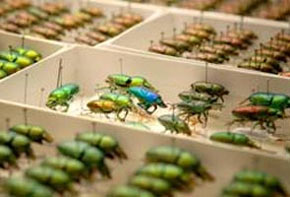

In a letter published in Nature, biologists at Universidade de São Paulo - Ribeirão Preto defend institutionalization of biological collections. With the support of FAPESP to organize archives, they are developing a project for the New Museum of Biodiversity
In a letter published in Nature, biologists defend institutionalization of biological collections. With the support of FAPESP to organize archives, they are developing a project for the New Museum of Biodiversity
In a letter published in Nature, biologists defend institutionalization of biological collections. With the support of FAPESP to organize archives, they are developing a project for the New Museum of Biodiversity

In a letter published in Nature, biologists at Universidade de São Paulo - Ribeirão Preto defend institutionalization of biological collections. With the support of FAPESP to organize archives, they are developing a project for the New Museum of Biodiversity
By Fábio de Castro
Agência FAPESP – The existing biological collections at universities in general are not included in the permanent budgets of institutions. Because of this, the limitations of financial resources jeopardize these archives which are fundamental to knowledge about biodiversity.
A group of researchers from Universidade de São Paulo - Ribeirão Preto’s School of Philosophy, Sciences and Letters (FFCLRP) raised these concerns in a letter published in April 21 edition of Nature magazine.
In the letter, Flávio Bockmann, from FFCLRP-USP’s Biology Department and colleagues announced that they are uniting collections scattered in diverse laboratories to form the Museum of Biodiversity. The initiative was supported by FAPESP through a project selected in the call for proposals on Research Infrastructure – Information Deposit Centers, Documents and Biological Collections
According to the authors of the text, the universities with well structured scientific collections provide a rich environment for biological training that will later be responsible for dealing with the most pressing issues concerning conservation of biodiversity.
Bockmann explains that the immense volume of biological material stored in innumerous other Brazilian universities is increasing exponentially as higher education expands in the country.
“It is fundamental that other Brazilian universities take similar initiatives, consolidating their collections and coordinating efforts in research on biodiversity to contribute to conservation and management policies,” he told Agência FAPESP.
Bockmann stresses that generally large museums begin with scientific collections that start out by being built by university researchers. But in order for them to become museums, an investment must be made to afford institutionalization of the material. If not, the material will remain scattered and many times is not lost solely because of the efforts of researchers.
“Today, we have a massive accumulated volume of scientific material in collections that are in different degrees of conservation and maintenance. The problem is that the responsibility for these archives is not defined in university bylaws,” he explained.
The problem of biological collections, according Bockmann, is worldwide. This prompted a group of researchers to publicize the Museum of Biodiversity initiative in Nature. In Brazil, the problem is more accentuated, since the country has the world’s largest biodiversity.
“We have large collections spread out in universities around the country, many times without the care they require. Furthermore, any study on environmental evaluation in the country demands that material collected be registered in a scientific collection. In our case, we received biological material continuously and the trend is for the archive to grow exponentially,” he affirmed.
According to Bockmann, FAPESP’s financial support allowed FFCLRP-USP to begin this process of institutionalization and organization of its collections. “FAPESP’s initiative to launch a specific call for proposals focused on management of biological collections is exemplary. Our expectation is that the museum project will create a multiplying effect, motivating other similar initiatives,” he said.
Maintenance of collections, according Bockmann, demands organizational investments, including the acquisition of servers and the implementation of archive management software – in addition to resources for physical infrastructure.
“We are utilizing the resources, for example, to create storage infrastructure, including modular compacting shelves and to acquire digital X-ray equipment, which is widely used in the vertebrate area. It is truly modest funding given the enormous results that it could bring,” he affirms.
According to the researcher, the forecast is for R$ 20 million to be invested in order for the first part of the museum to be completed and become fully operational. The total budget is estimated at R$ 70 million.
FFCLRP-USP’s collections, according to Bockman, include, for example, a vast herbarium and an important archive of fish, reptiles, crustaceans, paleontology and entomology, in addition to the largest collection of neotropical bees without stingers. Our estimate right now is that the archive has more than 600,000 samples. But the number is continuously growing,” he said.
These collections, according to Bockmann, will form the base for the museum’s exhibition archive. “This is an important part of the project, because we don’t want the museum to be only a pretext to store collections for research. We want to consolidate a high class research environment on biodiversity and create an international level public exhibition on the topic. The objective is ambitious: we want a museum that is a magnet on the national scenario, not just regional,” he affirmed.
Republish
The Agency FAPESP licenses news via Creative Commons (CC-BY-NC-ND) so that they can be republished free of charge and in a simple way by other digital or printed vehicles. Agência FAPESP must be credited as the source of the content being republished and the name of the reporter (if any) must be attributed. Using the HMTL button below allows compliance with these rules, detailed in Digital Republishing Policy FAPESP.





